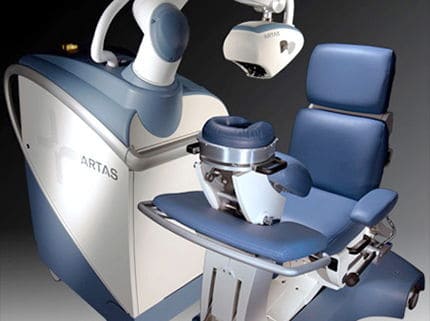As individuals age, they commonly experience hair loss or even balding. You may be surprised to know that more than fifty percent of women experience noticeable hair loss, and about eighty-five percent of men over the age of fifty are balding.
Most of these individuals are extremely unhappy with their hair loss. As a result, their interpersonal and professional lives may suffer. So what can be done to reverse hair loss?
Although numerous products on the market claim to restore a full head of hair, many of them leave much to be desired. Some treatments and medicines even cause unwanted side effects.
For this reason, many people are turning their attention to the ARTAS Robotic Hair Transplant System. It uses the follicular unit excision (FUE) method to provide permanent solutions for hair loss.
What is FUE?
FUE stands for follicular unit excision and involves transplanting healthy hair to the area affected by hair loss. It is one of two standard methods used in hair transplantations.
Hair growth occurs in follicular groups or units. Each follicular unit contains one to four follicles that all come from the same pore. FUE utilizes these units to promote new hair growth.
FUE vs. Strip Surgery
The alternative to FUE is strip surgery, also known as follicular unit transplantation (FUT). The main difference is how surgeons harvest hair in strip surgery. During the procedure, the surgeon cuts a wide strip of scalp with healthy follicles from the back of the patient’s head.
Then, the hairs are harvested from the section of the scalp and transplanted to the recipient area. The downside of strip surgery is that it is painful and requires prescription medicines during the recovery process, which lasts weeks. During this time, you will have to rest and not carry out your routine.
Unlike FUE, which leaves minimal scarring, strip surgery results in a large linear scar. In some rare cases, it causes side effects like numbness, tingling, pain, or tightness. FUE, on the other hand, does not pose these potential risks.
ARTAS Robot vs. Traditional FUE Hair Transplantations
The traditional approach to the FUE hair transplant was labor-intensive. It required surgeons to manually dissect hundreds and thousands of hair follicles from the patient’s donor area.
As a result, doctors were more likely to tire out or lose concentration. Even missing a graft by a few microns can cause damage the hair follicle and harm healthy hair.
ARTAS technology, a physician-assisted robot, has made this process much easier for surgeons. It allows surgeons to harvest each hair graft with precision and consistency throughout the procedure. As a result, ARTAS produces more effective long term hair growth results by eliminating the potential for human errors.
ARTAS- The Best Hair Treatment for Hair Loss
ARTAS offers many advantages to men and women who want to restore thinning hair. Many patients prefer this procedure since it is virtually painless and doesn’t involve scalpels or stitches.
Those who choose ARTAS don’t have to worry about the pain or scarring commonly associated with hair restoration procedures. They are also able to style their hair any way they want since there are no linear scars. Sometimes those who have had strip surgery in the past receive an ARTAS procedure to camouflage the scarred area.
Further, intelligent algorithms and advanced digital imaging allow for a quick, accurate, and consistent procedure. ARTAS detects exactly where each follicular unit should be transplanted. It restores hair in balding areas and helps protect existing hair follicles from thinning or damage.
Of course, the results that ARTAS provides are unmatched and leave the patient with fuller, natural-looking hair. These individuals will generally have a quick recovery as well since the procedure is minimally invasive. That means that they can start enjoying their new head of hair sooner than with other techniques.
Of course, hair growth is gradual with this procedure. That means you don’t have to worry about showing up to work one day with a full head of hair, making it evident that you’ve had a procedure. If you wish to be discreet, ARTAS makes that possible.
ARTAS Hair Transplant Procedure
When you receive a consultation, your physician will help you design a customized hairline with ARTAS Hair Studio. It will make a 3D model using your current photos, which will allow you to envision your results.
During your procedure, you will sit comfortably in a chair attached to the ARTAS system. You will need to cut your hair to 1mm in length. This length allows the robot’s artificial intelligence algorithms to identify healthy follicles that doctors can use as grafts.
After the surgeon harvests the needed hairs from the donor area, they will start with the transplantation process. By transferring your designed hairline model into the ARTAS system, your physician will know exactly where to place each follicular unit of hair. The ARTAS will do this quickly and accurately while your doctor controls each transplantation’s angles and parameters.
Recovering from ARTAS Hair Transplant
Since the procedure is relatively painless, you will not need to take strong painkillers. Most patients just take Tylenol. After a few days, you will be able to resume your routine.
About three months after your procedure, you will start to notice new permanent hairs appearing. The number of hairs growing will increase with time. There will be a visible improvement in six months, and after a year, you will enjoy your desired results.
Restore Your Hair With ARTAS in Dallas TX
Although many individuals suffer hair loss, few choose to take the proper steps to restore their hair. It does not have to be that way for you! With an ARTAS hair transplant, you can restore not only your healthy hair but also your confidence.
If you live in or near Dallas, TX, see us at The Paragon Hair Clinic! We will be happy to answer any questions you have regarding ARTAS and FUE technology.
Are you ready to renew your hair? Book your consultation today!






